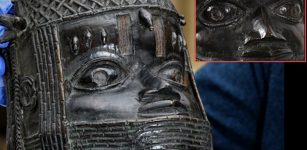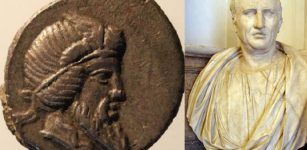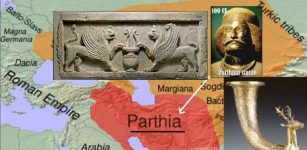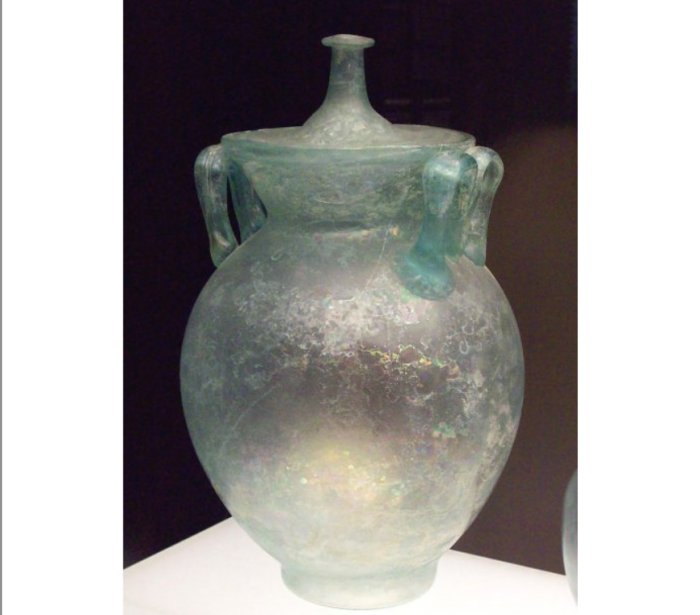Flexible Glass – Lost Ancient Roman Invention Because Glassmaker Was Beheaded By Emperor Tiberius
Ellen Lloyd - AncientPages.com - Did ancient Romans invent unbreakable glass? If they did, their secrets would be long lost because the Roman Emperor Tiberius beheaded the inventor of flexible glass.
A Roman blown-glass cinerary urn, dated between 1st and 3rd centuries AD. Image credit: Luis García - CC BY-SA 3.0
According to Roman authors Petronius (c. 27–66 AD) and Pliny the Elder (23–79 AD), a glassmaker was granted an audience with Emperor Tiberius. The glassmaker presented an incredible invention called a phiale (a shallow drinking vessel). The drinking bowl must have been made out of extraordinary material because he failed when the Roman Emperor Tiberius Caesar attempted to break the bowl.
Instead of breaking, the bowl dented like a bronze vessel. The glassmaker took out a hammer and removed the dent.
When Emperor Tiberius asked if anyone else knew how to make this kind of glass, the proud inventor replied that he knew the manufacturing technique. Unfortunately, the Emperor was by no means impressed.
Emperor Tiberius feared that such remarkable material could undermine the value of gold and silver and gave the order to behead the inventor.
In his Naturalis Historia, Pliny the Elder relates the story, but he also clarifies that he doesn’t believe anyone invented flexible glass (vitrum flexile). According to Pliny, the Elder, it’s just a story.
Another version of the story is told by Dio Cassius (AD 150–235), a Roman statesman and historian of Greek origin. Dio Cassius wrote in his Historia Romana that ‘an architect whose name no one knows’ aroused the jealousy of Emperor Tiberius, who exiled him. Emperor Tiberius was jealous of the architect’s skills.
Portrait of Roman Emperor Tiberius in Ny Carlsberg Glyptotek, Copenhagen. Original. Cast in Rome. Image credit: Cnyborg - Public Domain
“About this time, one of the largest porticos in Rome began to lean to one side and was set upright in a remarkable way by an architect whose name no one knows because Tiberius, jealous of his wonderful achievement, would not permit it to be entered in the records. This architect, then, whatever his name may have been, first strengthened the foundations roundabout so that they should not collapse, and wrapped all the rest of the structure in fleeces and thick garments, binding it firmly together on all sides by means of ropes; then with the aid of many men and windlasses, he raised it back to its original position.
At the time, Tiberius both admired and envied him; for the former reason, he honored him with a present of money, and for the latter, he expelled him from the city. Later the exile approached him to crave pardon, and while doing so, he purposely let a crystal goblet fall; and though it was bruised in some way or shattered, he promptly exhibited it whole once more by passing his hands over it. He hoped to obtain pardon for this, but instead, the Emperor put him to death.” (Historia Romana 57.21.7).
Whether the story is just a myth or there is some truth behind it, it is impossible to say. No example of Roman vitreum flexible is known to exist.
Could a Roman inventor have invented a form of break-resistant, denting glass? Modern scientists are attempting to develop flexible glass that will be used in smartphones.
It is important to remember that Roman glassmaking peaked during the early Imperial period, around the 1st century AD.
 The map depicts the Roman Empire in 117 C.E., at the height of the Pax Romana. (background) Image credit: ushistory.org
The map depicts the Roman Empire in 117 C.E., at the height of the Pax Romana. (background) Image credit: ushistory.org
The Pax Romana (‘Roman Peace’) was a period of relative peace and stability across the Roman Empire that lasted for over 200 years, beginning with the reign of Augustus (27 BC – 14 CE), the first emperor of Rome to the rule of Marcus Aurelius (161 -180 CE).
During this period, there were constant improvements in glassmaking techniques. It was also a time when glassblowing was invented. It was quicker and required fewer resources per vessel than earlier methods. Ancient Romans started to produce colorless glass, window panes, and glass mosaics. Historians say Roman glassmaking was so advanced that some achievements could only be replicated in the 18th century.
An inventor could have successfully produced flexible glass, but he made a mistake in showing the Emperor his achievement.
There are several examples of ancient Roman inventions that changed the world. Ancient Romans were skilled inventors who were not afraid of experimenting with technology. As a result of their efforts, we can today benefit from various surgical tools, bound books, aqueducts, and many other things we take for granted.
Written by Ellen Lloyd – AncientPages.com
Updated on July 26, 2023
Copyright © AncientPages.com All rights reserved. This material may not be published, broadcast, rewritten or redistributed in whole or part without the express written permission of AncientPages.com
Expand for referencesRoman Mold-blown Glass: The First Through Sixth Centuries
By E. M. Stern, Toledo Museum of Art
Isidore of Seville (2006). The Etymologies
More From Ancient Pages
-
 Benin Bronze Sculpture Looted By British Soldiers In Nigeria – Returns Home
Archaeology | Apr 2, 2021
Benin Bronze Sculpture Looted By British Soldiers In Nigeria – Returns Home
Archaeology | Apr 2, 2021 -
 Large 1,500-Year-Old Winepress Unearthed In Area Once Known For Wine production.
Archaeology | Oct 29, 2015
Large 1,500-Year-Old Winepress Unearthed In Area Once Known For Wine production.
Archaeology | Oct 29, 2015 -
 LIDAR Discovers Huge Abandoned Zapotec City With Temples, And Ball Courts In Oaxaca, Mexico
Archaeology | Jan 30, 2025
LIDAR Discovers Huge Abandoned Zapotec City With Temples, And Ball Courts In Oaxaca, Mexico
Archaeology | Jan 30, 2025 -
 Yomi – Kingdom Of The Dead In Japan’s Native Shinto Religion
Featured Stories | Jun 7, 2021
Yomi – Kingdom Of The Dead In Japan’s Native Shinto Religion
Featured Stories | Jun 7, 2021 -
 Ancient DNA Reveals The World’s Oldest Family Tree
Archaeology | Dec 27, 2021
Ancient DNA Reveals The World’s Oldest Family Tree
Archaeology | Dec 27, 2021 -
 Scientists Solve The Mystery Of Cicero’s Puzzling Words By Analyzing Ancient Roman Coins – Evidence Of Financial Crisis?
Artifacts | Apr 6, 2022
Scientists Solve The Mystery Of Cicero’s Puzzling Words By Analyzing Ancient Roman Coins – Evidence Of Financial Crisis?
Artifacts | Apr 6, 2022 -
 Khonsu: Enigmatic Egyptian Moon God, Healer, Protector And His Dark Side
Egyptian Mythology | Mar 12, 2019
Khonsu: Enigmatic Egyptian Moon God, Healer, Protector And His Dark Side
Egyptian Mythology | Mar 12, 2019 -
 Grinding Stone Sheds New Light On The Diet Of Early Neolithic Farmers In Scandinavia
Archaeology | Dec 30, 2024
Grinding Stone Sheds New Light On The Diet Of Early Neolithic Farmers In Scandinavia
Archaeology | Dec 30, 2024 -
 Next Discovery In Tepe Ashraf, Isfahan – Archaeologists May Have Stumbled Upon Ancient Necropolis
Archaeology | Aug 16, 2020
Next Discovery In Tepe Ashraf, Isfahan – Archaeologists May Have Stumbled Upon Ancient Necropolis
Archaeology | Aug 16, 2020 -
 Unknown Ancient Settlement Overlapping The Old City Of Nakhon Ratchasima Discovered
Archaeology | Mar 14, 2025
Unknown Ancient Settlement Overlapping The Old City Of Nakhon Ratchasima Discovered
Archaeology | Mar 14, 2025 -
 Lada: Jump Over Fire For Goddess Of Beauty, Love, And Marriage In Slavic Mythology
Featured Stories | Dec 11, 2017
Lada: Jump Over Fire For Goddess Of Beauty, Love, And Marriage In Slavic Mythology
Featured Stories | Dec 11, 2017 -
 500-Year-Old Shiva Temple Constructed On Rock Without Foundation Pits Needs Repairs
News | Sep 7, 2015
500-Year-Old Shiva Temple Constructed On Rock Without Foundation Pits Needs Repairs
News | Sep 7, 2015 -
 1,300-Year-Old Art Mystery Solved By Scientist
Archaeology | Sep 7, 2022
1,300-Year-Old Art Mystery Solved By Scientist
Archaeology | Sep 7, 2022 -
 On This Day In History: Sack Of Rome Took Place on May 6, 1527
News | May 6, 2016
On This Day In History: Sack Of Rome Took Place on May 6, 1527
News | May 6, 2016 -
 Glima – Ancient Martial Art Practiced By The Vikings Is Still Popular Today
Ancient Traditions And Customs | Mar 7, 2017
Glima – Ancient Martial Art Practiced By The Vikings Is Still Popular Today
Ancient Traditions And Customs | Mar 7, 2017 -
 Sculpted Head Of Ancient Warrior Wearing A Serpent Helmet Found At Chichen Itza
Archaeology | Nov 13, 2023
Sculpted Head Of Ancient Warrior Wearing A Serpent Helmet Found At Chichen Itza
Archaeology | Nov 13, 2023 -
 A 4,500-Year-Old Collective Tomb In France Reveals Its Secret – The Final Stage In The Formation Of The ‘European Genome’
Featured Stories | Jul 5, 2024
A 4,500-Year-Old Collective Tomb In France Reveals Its Secret – The Final Stage In The Formation Of The ‘European Genome’
Featured Stories | Jul 5, 2024 -
 On This Day In History: Mount Tambora Volcano Begins A Three-Month-Long Eruption – On Apr 10, 1815
News | Apr 10, 2017
On This Day In History: Mount Tambora Volcano Begins A Three-Month-Long Eruption – On Apr 10, 1815
News | Apr 10, 2017 -
 Highly Advanced Robots In Ancient China
Ancient Technology | Aug 7, 2015
Highly Advanced Robots In Ancient China
Ancient Technology | Aug 7, 2015 -
 Interbreeding With Modern Humans Wiped Out Neanderthals’ Y Chromosomes 100,000 Years Ago
Archaeology | Sep 28, 2020
Interbreeding With Modern Humans Wiped Out Neanderthals’ Y Chromosomes 100,000 Years Ago
Archaeology | Sep 28, 2020


